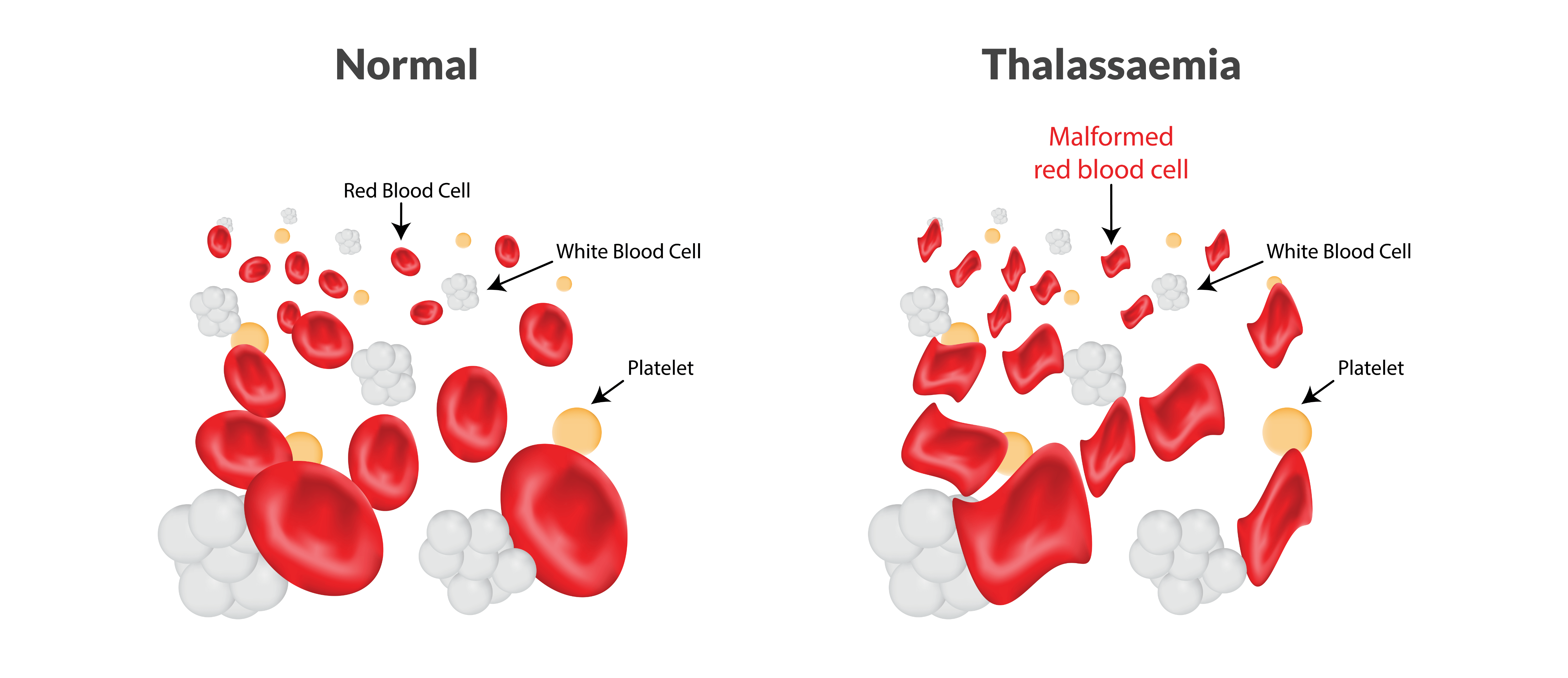Thalassaemia is an inherited (genetic) condition affecting the blood. There are different types of thalassemia. Depending on which type you have, thalassaemia may cause no illness at all, or may be a serious lifelong condition requiring treatment. It is one of the most prevalent inherited blood disorder in the population of Pakistan.
Signs and symptoms:
Thalassemia major can present in the first year of life with the following signs and symptoms:
- tiredness and a general lack of energy
- excessive crying and turning blue
- irregular and pounding heartbeat
- pale skini
- yellow eyes and skin
Repeated and frequent blood transfusions are needed to correct the anemia caused by the disease and these come at a price of iron deposition in the various organs of the body such as the liver, spleen, and heart. Thalassemia major patients can prevent lifelong morbidity and lead a normal life with careful monitoring of the disease and iron chelation.
When to see a doctor?
You must visit a doctor if you have a family history of thalassemia or the thalassemia trait or if you find out that your spouse is a carrier for the thalassemia trait. Antenatal testing can be done if you are already pregnant. There is a 25% chance of having a child with thalassemia major if both parents have thassemia trait.
If you suspect that your child may have thalassemia major or minor, get him examined by a pediatrician and tested for full blood count and hemoglobin electrophoresis.
تھیلیسیمیا۔
تھیلیسیمیا ایک موروثی (جینیاتی) مرض ہے جو خون کو متاثر کرتا ہے۔ تھیلیسیمیا کی مختلف اقسام ہیں۔ یہ ان قسم پر منحصر ہے کہ تھیلیسیمیا کی کیا علامات ہو سکتی ہیں۔ بعض اوقات یہ کسی بیماری کا سبب نہیں بنتا اور شدید اقسام میں زندگی بھر ایک ایسی سنگین حالت ہوسکتی ہے جس میں علاج کی ضرورت ہوتی ہے۔ یہ پاکستان کی آبادی میں وراثت میں ملنے والی خون کی خرابیوں میں سے ایک عام بیماری ہے۔
نشانات و علامات:
تھیلیسیمیا میجر زندگی کے پہلے سال میں درج ذیل علامات کے ساتھ ظاہر ہو سکتا ہے۔
- تھکاوٹ اور توانائی کی عمومی کمی۔
- ضرورت سے زیادہ رونا اور نیلا پڑ جانا ہونا۔
- تیز دل کی دھڑکن
- زرد رنگ کی آنکھیں اور جلد
تھیلیسیمیا کی وجہ سے ہونے والی خون کی کمی کو درست کرنے کے لیے بار بار اور خون کی منتقلی کی ضرورت ہوتی ہے اور یہ وافر مقدار میں فولاد جسم کے مختلف اعضاء مثلا جگر ، تلی اور دل میں جمع ہونا شروع ہو جاتا ہے۔ تھیلیسیمیا میجر کے مریض ایک نارمل زندگی گزار سکتے ہیں۔ بیماری کی محتاط نگرانی اور آئرن کیلیشن (chelation) کے ساتھ بیماری کی روک تھام ممکن ہے۔
ڈاکٹر سے کب ملنا ہے:
اگر آپ کے خاندان میں تھیلیسیمیا کی بیماری پائی جاتی ہے یا اگر آپ کو علم ہو کہ آپ کا شریک حیات تھیلیسیمیا مائنر کے مریض ہیں تو آپ کو ڈاکٹر سے ملنا چاہیے۔ اگر آپ پہلے سے حاملہ ہیں تو قبل از پیدائش ٹیسٹ کیا جا سکتا ہے۔ اگر دونوں والدین میں تھاسیمیا کی خصوصیت ہو تو تھیلیسیمیا میجر کے ساتھ بچہ پیدا ہونے کا 25 فیصد امکان ہے۔ اگر آپ کو شک ہے کہ آپ کے بچے کو تھیلیسیمیا میجر یا مائنر ہو سکتا ہے تو اس کا ماہر امراض اطفال سے معائنہ کروائیں اور بلڈ کاؤنٹ اور ہیموگلوبن الیکٹروفورسس (haemoglobin electrophoresis) کے لیے ٹیسٹ کروائیں۔
Doctors to consult (General Haematology):
Dr. Mubashir Khan Razzaq, Dr. Nauman Khan
Note: Click the Doctor's name to make an appointment.
Reference:
https://www.nhs.uk/conditions/thalassaemia
https://www.cdc.gov/ncbddd/thalassemia/index.html

